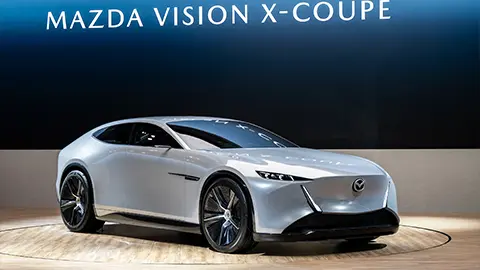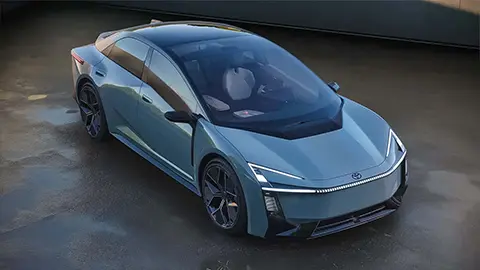Nissan: EV Leader Shows Off New Models
Nissan is an electric car leader, having introduced the Leaf to the U.S. more than a decade ago. But, other than the new (and rather excellent) Ariya SUV, much of its lineup has yet to be electrified. All of that is about to change. At the recent Japan Mobility Show, Nissan unveiled a full suite of electric car concepts, targeted at different market segments, which hint at future models to come. And all of them are united by the use of the company’s new All Solid State Battery (ASSB) technology.
All Solid State Batteries
The Japanese company has been hard at work on solid state batteries for a long time, and ASSB was announced about two years ago. Nissan says that the technology could revolutionize its electric cars. With almost double the energy density of current lithium-ion batteries, all with faster charging performance, and a lower overall cost.
Solid state batteries’ higher power density gives engineers and designers way more options in terms of how to package vehicles and powertrains. The batteries can be made smaller or lighter, while delivering the same amount of range, making sports cars and sedans more responsive. Or, if batteries remain the same size, they can offer more power and more range for less money. Getting more energy out of every ounce of battery could make larger, heavier vehicles like trucks or vans much more capable without having a huge, heavy battery pack. ASSB technology also is supposed to offer a wider temperature “sweet spot,” making them more suitable for use in hot climates, even without a dedicated and heavy cooling system.
How could solid state batteries be used in future Nissans? Four concept cars shown at the Japan Mobility Show demonstrate their potential in four very different formats.

Hyper Urban City Car
Created for city commuters, the Nissan Hyper Urban is a sophisticated commuter car that prioritizes sustainability above everything. Sleek and modern, it uses a very compact ASSB battery, which allows for a lightweight, compact package. The Hyper Urban is designed to be fully integrated into a city’s EV ecosystem; its vehicle-to-grid capability allows owners to “share” their batteries’ charge with the grid, reducing operating costs and helping to reduce overall energy consumption. Intelligent charging management uses AI to ensure it always has the power it needs.
The Hyper Urban’s commitment to sustainability extends throughout its architecture. Both hardware and software updates will be available to keep the ownership experience fresh. Over-the-air updates combine with interchangeable interior components made of recyclable materials. The Hyper Urban also works as a comfortable personal space: the instrument panel and infotainment display can be customized, while the front seats collapse and fold into the back seats to create a sofa-like space for relaxation.

High-Performance Nissan Hyper Force
At the other end of the performance spectrum, the Nissan Hyper Force concept combines eco-friendliness with extreme performance, and is Nissan’s vision for a next-generation electric supercar. The high-output powertrain, built around ASSB batteries, offers optimal weight distribution and over 1,000 horsepower with all-wheel drive and rapid acceleration. The lightweight body is sculpted aggressively to produce downforce to enhance cornering on road and track.
The Hyper Force features two driving modes – R for racing, and GT for grand touring. Switching modes changes the interior ambiance, and R mode even moves interior panels within the cockpit to create a more intimate feel for the driver. Four satellite screens, with graphics designed by the same company responsible for the Gran Turismo games, provide the driver with all necessary information.
When the vehicle isn’t moving – for instance, when it’s charging – Nissan has embedded augmented reality (AR) and virtual reality (VR) technology that blends the physical and virtual worlds. A special helmet visor with VR offers an immersive gaming experience that connects the driver with other virtual racers.

Nissan Hyper Tourer Luxury Minivan
If you dream about road tripping with the family, the Nissan Hyper Tourer is for you. It re-imagines the minivan experience with a luxurious, futuristic package full of advanced technology, including the ability to drive autonomously.
Compact solid-state batteries and small electric motors make the Hyper Tourer incredibly spacious; it has an ultra-low center of gravity, standard all-wheel drive, and fully autonomous driving capability. V2X (vehicle-to-everything) functionality allows it to communicate with other vehicles on the road, letting driver and front passengers to swivel their seats to socialize with rear-seat passengers. Inside, the overhead console and lighting are inspired by traditional Japanese architecture and textiles, and the floor is actually a flat LED screen that displays imagery of different natural environments.
Like the Hyper Urban, the Hyper Tourer minivan’s high-capacity battery can work in cooperation with the grid, supplying electricity to homes, stores, and offices, when it’s not being used to travel. Its smooth, sharp exterior harmonizes well with every landscape, hinting at the seamless nature of its driving and passenger experience.

Nissan Hyper Punk City Crossover
The funkiest of Nissan’s four concept cars is called the Hyper Punk. A crossover designed specifically for content creators, it’s built around the concept of self-expression. V2X technology means that drivers’ devices are always charged, while the vehicle’s energy can be shared with other collaborators.
The Hyper Punk’s interior is a festival of origami shapes and digital art. On-board cameras can capture the scenery around the car and convert it to graphic patterns that are projected around the interior’s three display screens – creating “a space where reality and the world of the metaverse are fused together,” says Nissan.
The Road to Solid State
Nissan’s four concept cars show off the wealth of potential options that solid state ASSB technology opens up for Nissan product planners, designers, and engineers. From city cars to supercars; for families and for expressive creators, EVs powered by solid state batteries will offer more choice as well as better performance and economy.
While Nissan says it still has many challenges to work out on the engineering front, the company says that it expects its first EVs powered by solid state batteries to hit the road as soon as 2028.
















